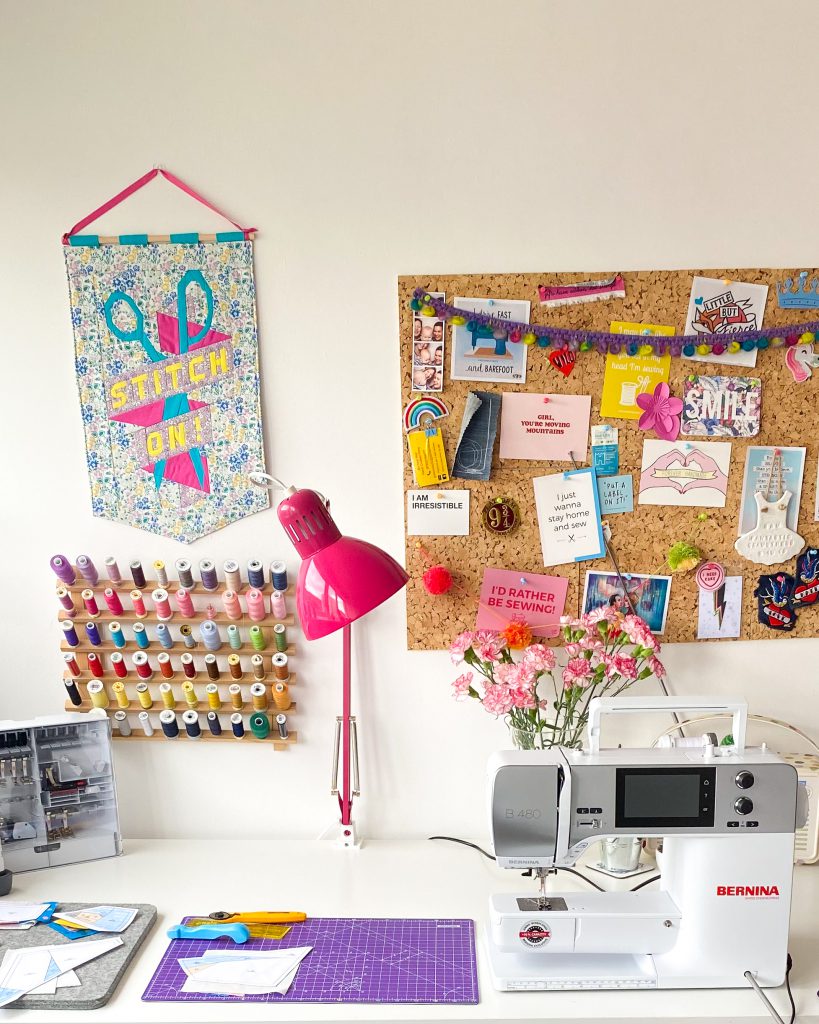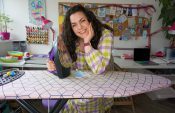Hi, I’m Samantha.
This is the first in a series of posts I’m going to be writing on sewing with chronic illnesses and disabilities, I don’t think these posts are just for folks with health conditions, I hope there’s things in them that will help everyone.
Lets talk about pacing…
Today I want to talk to you about pacing, I think this covers quilting or garment sewing, well, any type of sewing really. Sewing brings me much joy but it’s also very important for me to make sure I do it in a way that doesn’t damage my health.
So I’ve been sewing for several years now and pacing is a method that I find helps me to sew without experiencing any extreme fatigue or pain. I find it’s so easy to get sucked into a project and forget the world around you, I like to call this ‘a sewing vortex’. When I’m in a sewing vortex I ignore the world around me and that includes ignoring my body when it’s asking me for rest.
What is pacing?
For me, pacing is taking small chucks of time depending on what I think my body is capable of or and setting that as a limit. I like to be strict with my limits and I set a timer on my phone or use something like my putting my dinner in the oven. The time I give myself is also dependant on the task, if its a task that involves lots of movement like pressing a large piece of fabric I will reduce the time.
Pacing examples –
Here’s some examples of the time limits or sewing timers I give myself:
- When my body is feeling well I can sit at my sewing machine for 1 hour.
- When my body is tired I can sit at my sewing machine for a maximum of 20 minutes.
- When my body is well I can iron fabric for 15 mins. When my body is tired I won’t iron large pieces of fabric and do a different task instead.
- When my body is well I can cut out fabric for projects for 30 mins.
- When my body is tired I can cut out fabric for projects for 15 mins.
Pacing Rules
The most important part of these limits is when the timer ends I down my tools and walk away to take a rest, sometimes I do some stretches. After I’ve rested I will evaluate my body and if I’m feeling up to it I’m allowed to go back to my sewing room and do some more with another timer. If I’m not well enough to return to sewing thats ok too, there’s always tomorrow.
The most important thing to remember is it doesn’t matter how long a project takes you to finish, no one is timing you, this isn’t a TV show you can take as long as you need!
Happy sewing,
Samantha x
 BERNINA Corporate Blog -
BERNINA Corporate Blog -



Hi Samantha, this is a bit of a late response. I found your article helpful and thought provoking. I had a stroke last year and have struggled with fatigue ever since. Whilst I know I need to limit how much time I spend on exercise or physical chores such as gardening, I had never really thought about pacing myself when sewing and other hobbies. But it makes perfect sense and has encouraged me to break up projects into bite size pieces.Also, it’s great to see someone from the North East on this blog. I’m Scottish but lived in Gosforth for over 20 years before moving to the North West.
Lovely to find you here. As a relatively able bodied and physically well person I always learn so much from your content, both in terms of excellent ideas that are useful for any of us who fall into the vortex but also in considering what others experiences may be like and considering what needs and adaptations they may potentially be looking for . Thank you so much for sharing your experiences.
Thank you and I look forward to hearing more from you! I have mild MS and spasticity is something I deal with every day. If I sit too long the stiffness is worse, so I help myself by getting up often, to press or cut out more pieces. All time spent sewing is a joy to me.
Dear Samantha, this is a powerful article! Thank you for giving us a heads-up about structured rest times. We do, indeed, find ourselves in a “sewing vortex” and need help coming back to earth… or even the bathroom! “Rest and no Stress’t”!Everything of the best,Judith in Belfast, Northern Ireland ?☘
I am so glad that you wrote this article to remind us to slow down. I love to sew and too often will sew tooo long and then suffer. I have fibromyalgia and have had 3 back surgeries and arthritis in my hands and ft. But I keep going and going and will remember this from now on Thanks a bunch.
This article series is excellent in timing for me, as I have to restrict myself with sewing among other things/chores to reduce the pain and fatigue it can generate. Sewing is my Happy Place and it so easy to fall in that vortex. Thanks for suggesting a timer (which I only used so I did not overcook dinner or miss an appt!)
For me, sewing is all about having the right tools. I have the more severe form of macular degeneration. I have lost all central vision in one eye, and much of it in the other. Lighting is critical; I need much more bright white light than anyone else. I also need magnification, so I use a large LED magnifying lamp. Distortion is a more difficult problem to overcome, as lines seem to undulate, making cutting out a pattern by hand nearly impossible. I bought a Cricut Maker to cut my fabrics and interfacings for me with its tiny rotary blade, and I don’t try to sew things that exceed the size of the mats that the machine uses. The machine will also use a fabric marker to mark the stitching lines for me! Because I enjoy bag and basket making most of all, I don’t really miss sewing garments, curtains, or other large-scale projects. I also love to design, and the Cricut software handles that well, too, and so does the Silhouette machine software. I use project boxes to keep everything a project will need I one place, because it is all too easy to lose sight of a small object. I divide the various activities into limited periods of time. Cut the outer fabric in one session, lining in another, and so forth. Then I sew in sections of time also. There are more and more small patterns being made into the file format needed by cutting machines all the time (hooray!), and those in PDF format can be taken apart digitally by using an app, and then uploaded as an image in the Cricut software. Technology makes it possible for me to continue to use my beloved Bernina far longer than most people believed could be done, considering my poor state of vision. More real hope is now in sight for successful treatments to halt progression of this disease than there has ever been, so I am encouraged to keep taking this journey one day at a time. Thanks to my Bernina’s precision sewing and all the attachments that let me achieve great quality, I can still sew quite well! I get help for life’s other activities from the Florida Center For The Blind which is located in my city. More is possible than most people believe!
Because I have hand and feet issues, I’ve found it almost impossible to use the free hand system. My leg just doesn’t want to work that knee lift! But I love the “cruise control” of BERNINA. I can set my max speed to be VERY slow and know that I can keep control of my project that way. I just push the green “go” button and then guide the fabric. I have tremors and using the foot pedal is also pretty dicey most of the time so my go to thing is the speed control slider.
I love this article and appreciate your comments. I have Parkinson’s Disease and it has severely affected how much sewing I can do at any time. I avoid hand sewing at all costs and prefer to figure out how to do the same things by machine. I tend to get laser focused on my projects (also a Parkinson’s result) and my husband will occasionally come in and remind me to take a break. Thank goodness he sets alarms to remind me to take my meds! I need to learn to pace myself when I’m having a bad day. Thanks for writing this article.
Thank you!!!! This article was so very relevant for me!!!
Thank you, good tip. I try not to do more than 2 hrs max but sometimes 20 mins is plenty.